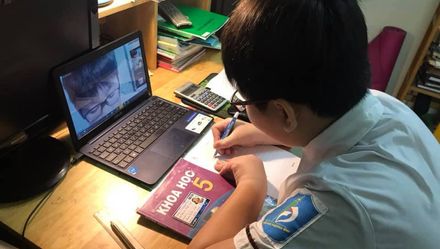Amid the COVID-19 pandemic, the majority of schools in Vietnam, as well as the world, have switched to Distance Learning to safeguard students’ health. This urgent transformation has impacted every aspect of children’s lives, both negatively and positively. Distance Learning also opens many questions regarding education inequalities and children’s cyber safety.
Then, What Is Distance Learning? Let’s discuss it in this article.
Definition of Distance Education
According to Cambridge Dictionary, Distance Learning or e-learning is “a way of studying in which you do not attend a school, but you study from where you live, usually being taught and given work to do over the internet”. In short, Distance Education is studying at home through virtual platforms.
With the proliferation of technology, Distance Learning emerges as more people use the Internet, initially appearing as online courses and training. This unconventional way of learning grows on a larger scale as Covid-19 caused worldwide school closures.
At the moment, Distance Learning of normal schools usually takes place on virtual meeting platforms such as Zoom, Google Meet, or Microsoft Teams. On a school day, students connect to the Internet and study with digital devices at their house, interacting with their teachers and classmates through meeting chatbox or mics.

Negative and Positive Effects of Distance Learning
It is undeniable that Distance Learning is a vital alternative for education during the pandemic. Without it, all students would have been out of school for 2 years ever since quarantine started.
Distance Education ensures they can continue studying despite the spreading. Thus, it enhances students’ digital literacy, which is extremely beneficial for the future generation. Finally, remote learning helps to keep students in touch with their friends instead of being isolated at home for such a long period of time.
Nevertheless, school closures and Distance Learning have created new social problems such as unequal education, increasing the digital divide gap, etc. Although remote learning enables more pupils to learn during the pandemic, it also deters low-income ones from continuing education.
You can find more about their impacts by reading this article: How School Closures Affect Students?.
Poverty and Distance Education
At least 1/3 of the world’s schoolchildren unable to access remote learning during school closures
UNICEF’s REPORT
Poverty is one of the main reasons why many potential children cannot go to school. They are discouraged by the lack of educational opportunities. Some students have to travel hundreds of miles to enter school, while others don’t have enough money to buy appropriate supplies and clothes.
That being said, students who are lucky could receive supports from the government or charitable organizations like Project Sprouts. Now, because of the emergence of the contagious virus, poor students, even more, diverge from quality education.
Distance Learning requires decent Internet connections and devices to study in virtual classes, which are “luxurious” for students in low-income households. This learning alternative is not for everyone, especially those who live in poorer areas.
At Project Sprouts, we realize that we can not solve all the problems in a situation like this. But we can seek to make a difference in the lives of needy children by giving them school supplies and encouraging them to continue their education; we can give them winter coats, boots, and blankets to help them stay warm during the cold winter months.
Project Sprouts would love to have you be a part of our community and help us to help worthy children in North Vietnam.
You can find out more about Project Sprouts by clicking here or go to our give now page to donate by clicking here. As we are a grassroots organization, all funds go to help those in need.
Related Content:
How Can Education Help Fight Poverty?
The United Nations’ 4th Sustainable Development Goal – Quality Education has emphasized the importance of education in combating not only poverty but also other societal issues.
Learning how education can support impoverished people will help you understand why the world needs education and what the mission of Project Sprouts is
You can read more by reading How Can Education Help Fight Poverty? by clicking here
How School Closures Affect Students?
In 2018, there are about 260 million children who cannot go to school, this accounts for nearly one-fifth of the global population. That was 2 years before COVID-19 emerged. Now, the situation is dramatically different: it continues to exacerbate after new waves of COVID-19 have delayed schools’ opening. Many more students are out of school; meanwhile, some stopped learning because they lack digital devices to study online.
So, What is really happening?
You can learn more by reading How School Closures Affect Students?. by clicking here

